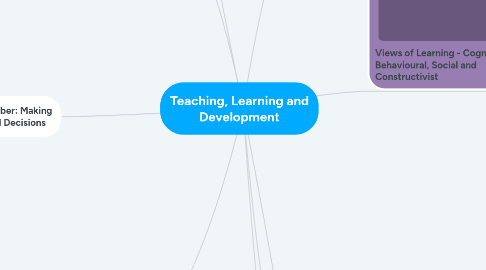
1. Early August: Planning for the Upcoming School Year
1.1. Educational Psychology: Uses knowledge and methods of psychology to study teaching and learning and improve these processes
1.1.1. Motivation/Individual Differences
1.1.1.1. Student-Centred Approach
1.1.2. Teaching and Instruction
1.1.2.1. Curricular Planning: determine curricula for year, for each term, break down into units, daily lesson plans
1.1.3. Development
1.1.3.1. Effective Planning: excellent instruction, enhanced student learning, exemplary environments
1.1.3.2. Behaviour/Classroom Management
2. First Week of School: Establishing a Positive Learning Environment
2.1. Well-Managed and Structured Classroom
2.1.1. Design of classroom curriculum for student-learning
2.1.1.1. Learning profile
2.1.1.1.1. Can develop motivation to learn
2.1.1.2. Interests/Personalities
2.1.1.2.1. Can promote self-efficacy, self-regulation
2.1.1.2.2. Can feel connected
2.1.1.3. Abilities/Readiness
2.1.1.3.1. Can develop sense of competence
2.1.2. Classroom management techniques
2.1.2.1. Bump system
2.1.2.1.1. Proximity
2.1.2.1.2. Student's name
2.1.2.1.3. Gesture
2.1.2.1.4. The "look"
2.1.2.1.5. The "pause"
3. Mid-September: Making Instructional Decisions
3.1. Meaningful Learning
3.1.1. Universal Instructional Design
3.1.1.1. Address the needs of the least independently able students in mind
3.1.1.2. Good for all, necessary for some
3.1.2. Student Motivation
3.1.2.1. Challenging and meaningful tasks
3.1.2.2. Having teacher support
3.1.2.3. Able to effectively use learning strategies
3.1.3. Teaching for Critical Thinking
3.1.3.1. Not just "what", but "how" and "why"
3.1.3.2. Evaluate and question other opinions
3.1.3.3. Argue in reasoned way rather than through emotions
3.1.4. Problem-based Learning
3.1.4.1. Teacher is facilitator rather than leader
3.1.4.2. Encourages identification of problem and activate prior knowledge which leads to elaboration of knowledge
3.1.5. Inquiry-based Learning
3.1.5.1. Teacher is source of driving questions
3.1.5.2. Encourages exploration, invention, and application
4. Early December: Individual Differences-Intellectual Abilities and Challenges
4.1. The Source of Intelligence
4.1.1. Exceptionalities
4.1.1.1. High-incidence: mild disabilities
4.1.1.1.1. Learning disabilities, behavioural disorders, giftedness
4.1.1.2. Low-incidence: moderate and severe disabilities
4.1.1.2.1. Autism, hearing and visual impairments, health issues
4.1.2. Inclusive Education
4.1.2.1. Children are different and all children can learn = change the system to fit the child
4.1.3. General intelligence
4.1.3.1. Learning from experience
4.1.3.2. Adapting to one's environment
5. Early February: Socio-Cultural Considerations
5.1. Celebrate Cultural Diversity
5.1.1. Individualism
5.1.1.1. Act within a unique identity and exclusive purpose
5.1.2. Collectivism
5.1.2.1. Act within a share identity and common purpose
5.1.3. Culturally Responsive Practice
5.1.3.1. Broad cultural knowledge and instructional base that grows and changes
5.1.3.1.1. Recognize own cultural assumptions
5.1.3.1.2. Learn how to inquire about students' backgrounds
5.1.3.1.3. Develop teaching and curriculum approaches to represent culturally diverse learners
5.1.3.2. Help eliminate stereotypes
5.1.3.3. Make connections across cultures
6. Late August: Considering Developmental Differences
6.1. Constructivist Views of Learning
6.1.1. Piaget
6.1.1.1. Schemas: organizing behaviours and thoughts into coherent systems
6.1.1.2. Adaptation: adjusting to one's surrounding environment
6.1.2. Vygotsky
6.1.2.1. Zone of proximal development: difference between learner's abilities with or without help
6.1.2.2. Scaffolding: assessing learner's current knowledge and relating content to what students already know or can do
6.1.3. Constructivist-based Classrooms
6.1.3.1. Differentiated Instruction
6.1.3.1.1. Providing different students with different avenues for effective learning
6.1.3.2. Universal Design for Learning
6.1.3.2.1. Multiple means of representation, expression, and engagement
6.1.3.3. Inquiry Learning/Problem-based Learning
6.1.3.3.1. Learning that starts with posing questions, problems, or scenarios
7. Views of Learning - Cognitive, Behavioural, Social and Constructivist
7.1. Cognitive
7.1.1. More related knowledge = better learning
7.2. Behavioural
7.2.1. Classical Conditioning
7.2.1.1. Biological potent stimulus pair with previously neutral stimulus
7.2.2. Operant Conditioning
7.2.2.1. Rewards and punishments for behaviour
7.3. Social
7.3.1. Self-Efficacy
7.3.1.1. One's belief in one's ability to succeed at a particular task
7.3.2. Motivation/Goals
7.3.2.1. Reason for people's actions, willingness, and goals
7.4. Constructivist
7.4.1. Making students aware of the knowledge construction process - becoming self-regulated learners
7.4.2. Student-centred instruction
7.4.3. Problem-based learning
8. Late September: Knowing that the Students Know
8.1. Beginning with the End in Mind
8.1.1. Backward Design: setting goals before choosing instructional methods or assessments
8.1.1.1. What to expect students to be able to do at the end of the course
8.1.1.1.1. Students should be able to describe the goals and performance requirements of the unit
8.1.1.2. How will teacher know that material has been learned
8.1.1.2.1. Authentic and purposeful activities/tasks, through differentiated instruction
8.1.1.3. What lessons will be most effective in helping students demonstrate their learning
8.1.1.3.1. Teaching for understanding
9. End of School Year: Standardized Assessments
9.1. Standardized Testing
9.1.1. Test Types
9.1.1.1. Criterion-Referenced
9.1.1.1.1. Score determined by comparing performance to established criteria
9.1.1.2. Norm-Referenced
9.1.1.2.1. Score determined by comparing performance to that of other students
9.1.2. To assess effectiveness of instruction
9.1.2.1. Scores in systematic and uniform manner
9.1.2.2. Administered to all test-takers in same fashion
9.1.2.3. Same questions for all test-takers
9.1.3. Criticisms
9.1.3.1. Biased tests
9.1.3.2. Stressful for students and teachers
9.1.3.3. Does not enhance student learning
9.1.3.4. Content of tests do not reflect instruction
